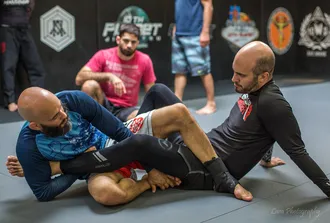
Brazilian Jiu-Jitsu (BJJ) is a martial art that has gained immense popularity worldwide, renowned for its intricate grappling techniques and mastery of ground fighting.
If you're new to Brazilian Jiu-Jitsu, martial arts, or you're considering starting, you've likely come across the terms "Gi" and "No-Gi" and wondered what they mean and how they differ.
In this comprehensive guide, we'll dive into the key differences between Gi and No-Gi BJJ, exploring their unique aspects, advantages, and which one might be best for your training goals.
BJJ Gi: The Traditional Attire
The Role of the Gi in BJJ
The Gi in BJJ refers to the traditional uniform worn by practitioners. It consists of a heavy cotton jacket, reinforced pants, and a belt, which signifies rank within the BJJ belt system. The Gi plays a crucial role in training and competition, allowing for a variety of grips, controls, and submissions that aren't possible in No-Gi BJJ.
Techniques and Strategies in Gi BJJ
Gi BJJ emphasizes grip fighting, leverage, and strategic control. Practitioners can use the fabric to execute chokes, control opponents, and implement Gi-specific guard techniques. Because of the friction and gripping options, the pace of Gi BJJ tends to be slower and more methodical, requiring patience and precision.
No-Gi BJJ: A Different Approach
What is BJJ No-Gi?
No-Gi Jiu-Jitsu, as the name suggests, is practiced without the traditional Gi. Instead, practitioners wear shorts and a rash guard, which prevents gripping opportunities. This makes No-Gi faster and more dynamic, often requiring better movement, body control, and adaptation to positions.
What Should I Wear to a No-Gi BJJ Class?
For No-Gi training, you'll need a rash guard or a fitted athletic shirt, along with grappling shorts without pockets. Pockets can cause injuries by snagging fingers or toes. Many practitioners also wear spats (compression leggings) under their shorts for extra protection against mat burns and to improve hygiene.
Techniques and Strategies in No-Gi BJJ
No-Gi BJJ focuses on clinching, body positioning, and wrestling-based movements since there are no fabric grips. Techniques often include underhooks, overhooks, body locks, and leg entanglements. Due to the lack of friction from the Gi, No-Gi tends to be faster-paced and more explosive.
Is No-Gi BJJ the Same as Wrestling?
While No-Gi BJJ shares similarities with wrestling, they are distinct disciplines. No-Gi Jiu-Jitsu includes a strong focus on submissions, positional control, and guard play, while wrestling prioritizes takedowns and pins. However, incorporating wrestling techniques into No-Gi BJJ is beneficial, as it enhances takedown ability and positional dominance.
BJJ Gi vs. No-Gi: Understanding the Key Differences
When comparing Gi and No-Gi Jiu-Jitsu, several key differences stand out:
- Training Gear: The Gi provides gripping opportunities that are not available in No-Gi, where practitioners rely solely on body grips.
- Pace and Style: No-Gi is generally faster and more explosive, while Gi BJJ is more methodical and strategic due to grip-based controls.
- Techniques and Strategy: Gi training includes a wider variety of chokes and grip-based submissions, whereas No-Gi incorporates more wrestling and leg attacks.
- Competition Rules: Gi competitions follow stricter rulesets, such as IBJJF regulations, while No-Gi often includes leg locks and heel hooks under ADCC-style rules.
| Aspect | Gi BJJ | No-Gi BJJ |
|---|---|---|
| Attire | Gi (jacket, pants, belt) | Rash guard, shorts, spats |
| Grip Options | Extensive, using the Gi fabric | Limited to body grips and clinching |
| Pace | Slower, more technical | Faster, more dynamic |
| Techniques | Gi chokes, sleeve/lapel controls | Wrestling-based takedowns, leg locks |
| Competition Rules | IBJJF-based rules, restricted leg attacks | ADCC rules, more leg lock options |
Choosing Between Gi and No-Gi BJJ
Deciding whether to train in Gi or No-Gi Brazilian Jiu-Jitsu depends on your personal preferences and goals. Here are some factors to consider:
- Your Martial Arts Goals: If you're interested in traditional BJJ or plan to compete in Gi tournaments, training in the Gi is essential. If you're more drawn to MMA, wrestling, or a faster-paced grappling style, No-Gi might be more appealing.
- Cross-Training Opportunities: Training in both Gi and No-Gi can provide a well-rounded skill set. Many practitioners train in both to reap the unique benefits and learnings from each style.
- Training Frequency: Your choice may also depend on how often you should train BJJ. Gi training can be more methodical, while No-Gi might require more athletic conditioning, impacting your weekly training schedule.
- Personal Preference: Some people simply prefer the feel and strategy of one style over the other. Try both and see which suits your unique journey.
The Benefits of Training Both Gi and No-Gi
While some practitioners prefer one style over the other, training in both Gi and No-Gi BJJ provides a well-rounded skill set. Here’s why:
- Improved Adaptability: Gi training enhances grip fighting, while No-Gi sharpens wrestling and scrambling ability.
- Technical Growth: The precision required in Gi helps refine techniques, while No-Gi builds speed and agility.
- Competition Versatility: Many top BJJ competitors excel in both styles, making them adaptable to different tournaments.
- Stronger Submission Game: No-Gi introduces more leg locks, while Gi offers advanced collar chokes and positional control.
- Extra Training Opportunities: Many academies offer BJJ open mat sessions, where practitioners can train freely in both Gi and No-Gi. These sessions allow for additional sparring time and exposure to different grappling styles.
Differences When Competing
Competing in BJJ, whether in Gi or No-Gi, presents unique challenges. Both styles require strategic thinking, technical execution, and adaptability. However, the rule sets, allowed techniques, and competition pacing differ significantly.
Competing in the Gi
Gi competitions tend to be more methodical, focusing on grip fighting, positional control, and strategy. The Gi allows competitors to slow down exchanges, control opponents using lapels and sleeves, and set up intricate guard strategies.
Common techniques in Gi competitions include:
- Collar chokes: Using the opponent's lapel to apply pressure.
- Sleeve and lapel control: For breaking posture and limiting movement.
- Guard play: Open guard variations thrive in Gi competitions.
Gi competitions typically follow IBJJF rules, which restrict certain submissions, especially lower-body attacks like heel hooks.
Competing in No-Gi
No-Gi BJJ competitions are often faster-paced and more explosive. Without Gi grips to slow the game down, competitors rely on wrestling-based techniques, quick transitions, and body control.
Common techniques in No-Gi competitions include:
- Leg locks: Heel hooks, kneebars, and ankle locks are more prevalent.
- Underhooks and overhooks: Controlling the body instead of fabric.
- Scrambling ability: Moving quickly between positions to secure dominance.
No-Gi competitions often follow ADCC rules, which allow a wider range of submissions, including reaping and heel hooks.
Rules and Regulations
| Aspect | Gi Competitions | No-Gi Competitions |
|---|---|---|
| Rule Set | IBJJF rules (strict on leg locks, lapel grips allowed) | ADCC rules (allows more leg locks, reaping permitted) |
| Legal Submissions | Limited leg locks, more focus on collar chokes and joint locks | Heel hooks (intermediate divisions), kneebars, and a broader range of submissions |
| Gripping | Extensive, using Gi fabric (lapels, sleeves, pants) | Limited to body grips, underhooks, overhooks |
| Game Speed | Slower, more methodical due to grips | Faster, more explosive transitions |
Why No-Gi BJJ is Growing in Popularity
Over the past decade, No-Gi BJJ has exploded in popularity. While traditional Gi Jiu-Jitsu remains a major part of the sport, more grapplers are shifting toward No-Gi training. Here’s why:
- 🔥 The MMA Connection: No-Gi Jiu-Jitsu is essential for mixed martial arts (MMA). Since there's no Gi in MMA, fighters prioritize No-Gi techniques that translate directly to real combat situations.
- ⚡ Faster-Paced & More Athletic: Without the friction of the Gi, No-Gi matches are quicker and more dynamic. Grapplers rely on speed, agility, and wrestling-style movements to control their opponents.
- 🦵 The Leg Lock Revolution: No-Gi has become the hub for advanced leg locks, particularly in high-level competitions like the ADCC. With fewer restrictions on heel hooks and kneebars, more practitioners are drawn to No-Gi for its evolving submission game.
- 🛠️ Practicality & Accessibility: No-Gi is often seen as more accessible for beginners since it requires less gear (just a rash guard and shorts). Many practitioners also find it easier to learn without having to worry about complex Gi grips.
- 🏆 ADCC, CJI & No-Gi Superfights: Events like the ADCC World Championship and the newly launched Craig Jones Invitational (CJI) are further fueling the rise of No-Gi Jiu-Jitsu. These high-profile tournaments showcase elite No-Gi grapplers and attract a growing global audience.
With its fast-paced nature, MMA crossover, and evolving leg lock game, No-Gi BJJ is becoming the preferred style for many modern grapplers.
FAQs: Gi vs. No-Gi BJJ
What is the main difference between Gi and No-Gi BJJ?
The primary difference is the attire and gripping methods. Gi BJJ allows practitioners to use the opponent’s Gi for grips, chokes, and control, leading to a more methodical pace. No-Gi BJJ eliminates fabric grips, resulting in a faster, more dynamic style that incorporates wrestling and body control.
What does No-Gi BJJ mean?
No-Gi BJJ refers to training without the traditional Gi. Instead of a jacket and pants, practitioners wear rash guards and grappling shorts. This changes the style of play, emphasizing body positioning, underhooks, and leg attacks instead of fabric-based grips.
Which is harder: Gi or No-Gi BJJ?
Both styles present unique challenges. Gi BJJ can be more technical due to grip-based control and the slower pace. No-Gi BJJ requires more athleticism, speed, and wrestling-based techniques. The difficulty depends on your natural strengths and preferences.
Does Gi BJJ make you better at No-Gi?
Yes! Training in Gi BJJ improves grip strength, patience, and technical precision, which can translate well into No-Gi. Conversely, No-Gi training enhances explosiveness and scrambling ability, which can benefit Gi practitioners.
Which is better for self-defense: Gi or No-Gi BJJ?
Both styles are useful for self-defense. Gi BJJ teaches grip control and leverage, which can be helpful if an opponent is wearing clothing. No-Gi BJJ is closer to real-life scenarios since people won’t always be wearing a jacket, and it incorporates more wrestling and takedowns.
Can I train both Gi and No-Gi at the same time?
Yes, many practitioners train both styles to become well-rounded grapplers. Training both improves adaptability, competition readiness, and overall Jiu-Jitsu skills.
Is No-Gi BJJ the same as wrestling?
No-Gi BJJ shares similarities with wrestling, such as clinching, takedowns, and positional control, but they are different disciplines. No-Gi BJJ includes submissions like chokes and joint locks, whereas wrestling focuses on pins and positional dominance. However, many No-Gi practitioners incorporate wrestling techniques into their game.
What are some tips for No-Gi BJJ?
To improve in No-Gi BJJ:
- Focus on underhooks and overhooks for control.
- Work on wrestling-based takedowns and sprawls.
- Drill leg lock defense, as leg attacks are more common in No-Gi.
- Improve conditioning since No-Gi matches tend to be faster-paced.
- Take advantage of BJJ open mat sessions to get extra No-Gi training time.
Is No-Gi BJJ better for MMA?
Yes, No-Gi BJJ is generally more applicable to MMA because it closely resembles real fights. Without Gi grips, No-Gi focuses on body control, takedowns, and fast-paced scrambling, all of which are crucial in mixed martial arts.
Do No-Gi competitions allow heel hooks?
Yes, most No-Gi competitions, especially those following ADCC rules, allow heel hooks, kneebars, and other leg locks. However, IBJJF No-Gi tournaments have restrictions at lower belt levels.
Conclusion: Train Both!
Whether you train in Gi BJJ, No-Gi BJJ, or both, Brazilian Jiu-Jitsu offers a rich and rewarding journey. Each style has unique advantages, and mastering both can make you a more complete grappler.
If you're unsure where to start, try both styles and see which resonates with you. Many practitioners find value in switching between Gi and No-Gi to develop a well-rounded skill set.
Embrace the learning process, enjoy the journey, and keep rolling!










